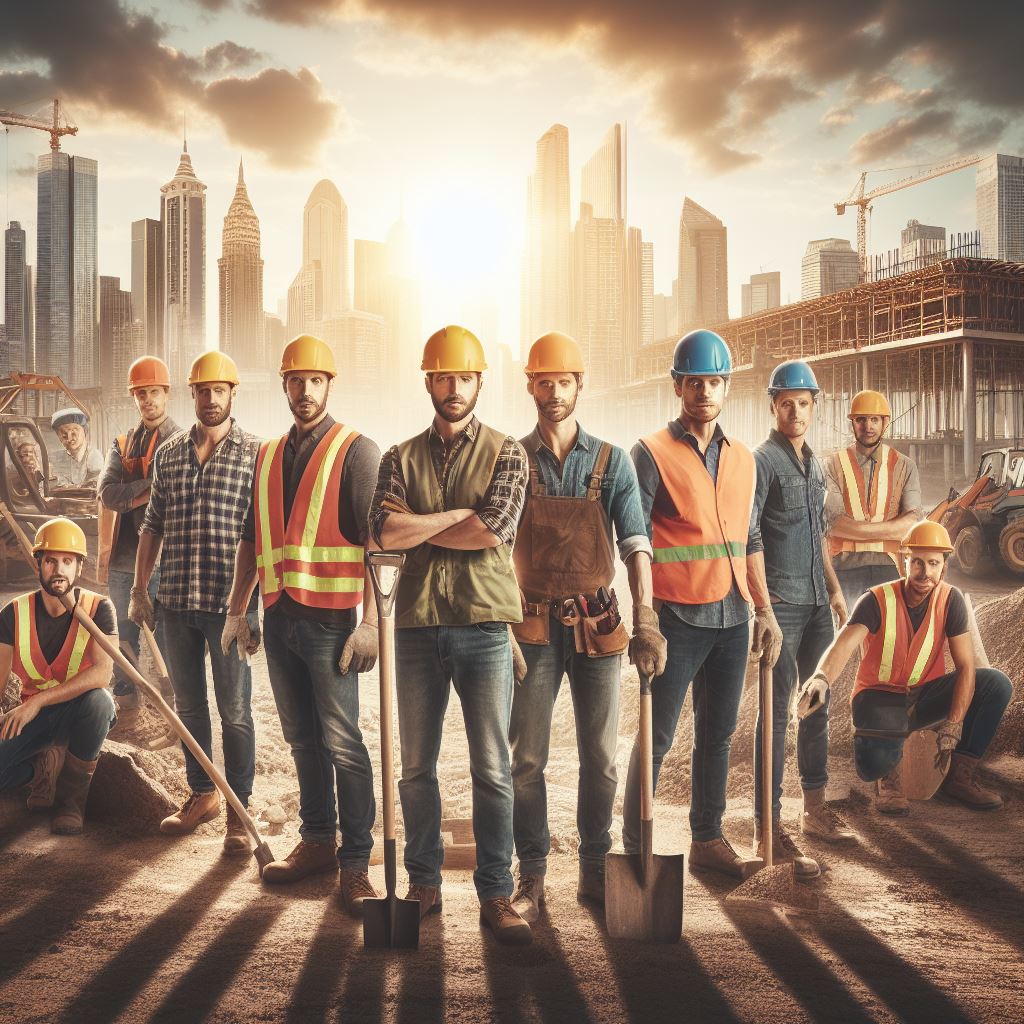Introduction
The US construction industry has a rich history and plays a significant role in the country’s economy.
Predicting industry trends in construction is crucial for effective planning and decision-making.
This blog post aims to discuss the importance of predicting US construction industry trends and its purpose.
The US construction industry has been a key contributor to the country’s economic growth and development.
From iconic landmarks to infrastructures, this industry has consistently played a vital role in shaping the nation’s landscape.
As an essential sector, it is imperative to accurately predict and anticipate trends that will shape its future.
Effective forecasting of industry trends provides valuable insights for stakeholders.
Builders, contractors, and investors rely on projections to gauge demand, plan projects, allocate resources, and make informed decisions.
By identifying what lies ahead, they can adjust strategies, boost profitability, and even gain a competitive edge in a dynamic market.
The purpose of this blog post is to emphasize the significance of predicting US construction industry trends.
It aims to provide readers with a comprehensive understanding of why industry forecasts matter and the impact they can have on various stakeholders.
Whether you are a construction professional, an investor, or simply interested in the industry’s future trajectory, this post will delve into the reasons for accurate predictions and their practical implications.
In the following sections, we will explore key factors influencing trends in the US construction industry and delve into recent developments and emerging technologies set to shape its future.
Through this blog post, we hope to equip readers with the knowledge they need to stay ahead of the curve and make informed decisions regarding the ever-evolving US construction industry.
Current State of the US Construction Industry
Overview of the industry’s current landscape
The US construction industry plays a crucial role in the country’s economy, contributing to job creation and infrastructure development.
It is a diverse sector that encompasses various activities, such as residential, commercial, and industrial construction.
The industry’s current landscape shows a steady growth trajectory, fueled by factors such as population growth, urbanization, and technology advancements.
Residential construction remains a significant segment of the industry, driven by increasing demand for housing propelled by a growing population.
Commercial construction, including office buildings, retail spaces, and hotels, also experiences steady growth, reflecting a strong business environment.
Furthermore, infrastructure development projects, such as roads, bridges, and airports, contribute to the industry’s landscape.
Transform Your Career Today
Unlock a personalized career strategy that drives real results. Get tailored advice and a roadmap designed just for you.
Start NowThe US construction industry is characterized by a diverse range of construction activities that support economic growth and development.
Key statistics and trends
Several key statistics and trends provide insights into the current state of the US construction industry:
- The industry’s total revenue reached $1.4 trillion in 2019, showing continued growth and demand for construction services.
- The residential construction market is projected to grow at a CAGR of 4% from 2020 to 2027, indicating sustained demand for housing.
- The commercial construction sector is expected to witness significant growth, driven by factors such as the rise of e-commerce and the need for modern office spaces.
- Technological advancements, such as Building Information Modeling (BIM) and prefabrication, are transforming the industry, improving efficiency, and reducing cost
- Sustainability and green building practices are gaining traction, with an increasing focus on energy-efficient construction and renewable materials.
- The labor shortage remains a challenge for the industry, as finding skilled workers becomes increasingly difficult.
Challenges faced by the industry
Despite its positive trajectory, the US construction industry faces certain challenges that affect its future outlook:
- The ongoing COVID-19 pandemic has disrupted construction activities, causing delays and affecting supply chains.
- Rising material costs and shortages pose challenges to construction projects, impacting budgets and timelines.
- Regulatory complexities and permitting processes can delay project approvals and increase costs for construction firms.
- The industry’s reliance on fossil fuels and the carbon footprint of construction activities contribute to environmental concerns.
- Workforce shortages and the lack of skilled workers remain persistent challenges, leading to increased labor costs and project delays.
- Infrastructure deficits, such as aging roads and bridges, require significant investments, which can strain government budgets.
Addressing these challenges requires collaborative efforts between industry stakeholders, policymakers, and technology providers.
Adopting innovative construction practices, investing in workforce development, and embracing sustainable solutions are essential for the industry’s long-term growth.
Inshort, the US construction industry is currently in a positive state, driven by various construction activities and growth sectors.
However, it faces challenges such as the ongoing pandemic, labor shortages, and environmental concerns that require proactive measures to ensure continued progress in the future.
By embracing technological advancements and sustainable practices, the industry can overcome these challenges and thrive in the coming years.
Read: Mental Well-being: Addressing Stress in Construction Work
Factors Affecting Future Construction Industry Trends
Economic factors
- GDP growth and its impact on construction
- Interest rates and their influence on investments
Demographic factors
- Population growth and its effect on demand
- Aging population and its implications
Technological advancements
- Impact of automation and robotics
- Adoption of innovative building materials
Environmental considerations
- Importance of sustainable construction practices
- Growth of green building initiatives
The future of the US construction industry is influenced by various factors. These factors, including economic, demographic, technological, and environmental aspects, shape the trends in this sector.
Economic factors
Economic factors play a vital role in determining the future outlook of the construction industry.
One key factor is GDP growth. When the economy experiences growth, it leads to increased construction activities.
A thriving economy creates more job opportunities, which drives the demand for construction projects.
Another economic factor that significantly affects the construction industry is interest rates.
Low interest rates encourage investments in real estate and construction projects.
Lower borrowing costs make it easier for developers and individuals to finance construction activities.
Conversely, high-interest rates can limit construction investments.
Demographic factors
The demographics of the US population also impact the construction industry.
Population growth directly correlates with the demand for residential, commercial, and infrastructure projects.
Showcase Your Business Today
Reach thousands of readers actively exploring professional services. Publish your business profile and grow your audience now.
Publish NowAs the population increases, there is a need for more housing, schools, hospitals, and transportation infrastructure.
Additionally, the aging population has implications for construction trends.
The elderly population requires specialized facilities such as retirement homes and healthcare facilities.
Adapting to the needs of an aging population creates opportunities for construction companies to develop age-friendly structures.
Technological advancements
The construction industry is continuously evolving due to technological advancements.
Automation and robotics are revolutionizing various construction processes.
Tasks such as bricklaying, welding, and material handling can now be automated, increasing efficiency and reducing labor costs.
Moreover, the adoption of innovative building materials is another technological trend that will shape the future of the construction industry.
Advanced materials, such as sustainable and energy-efficient products, are becoming more prevalent.
These materials offer improved durability, energy savings, and reduced environmental impact.
Environmental considerations
Environmental considerations are becoming increasingly important in the construction industry.
Sustainable construction practices are gaining traction as the industry strives to minimize its ecological footprint.
Utilizing renewable energy sources, implementing green building techniques, and reducing waste are essential for addressing environmental concerns.
Furthermore, the growth of green building initiatives is expected to continue.
Projects that prioritize energy efficiency, water conservation, and environmentally friendly construction practices are gaining popularity.
Government regulations and incentives further promote the adoption of sustainable construction methods.
Basically, several factors will shape the future trends in the US construction industry.
Economic factors, including GDP growth and interest rates, significantly influence construction investments.
Demographic factors, such as population growth and the aging population, impact the demand for various types of construction projects.
Technological advancements, like automation and innovative building materials, revolutionize construction processes.
Environmental considerations and the growth of green building initiatives are crucial for sustainable construction practices.
Read:US Welder Shortage: Myth or Reality in Today’s Market?

Discover More: Challenges Faced by Plumbers in the American South
Predicted Trends in the US Construction Industry
Increased investment in infrastructure projects
The US construction industry is expected to see a surge in investment in infrastructure projects, such as roads, bridges, and public transportation systems.
The government’s increased focus on improving the nation’s infrastructure will create numerous opportunities for construction companies.
The demand for updated and modernized infrastructure facilities will lead to significant growth in the industry.
Emphasis on sustainability and green building practices
There is a growing emphasis on sustainability and green building practices in the US construction industry.
Many construction companies are adopting environmentally friendly practices, such as using renewable materials and implementing energy-efficient technologies.
Green building certifications, like LEED (Leadership in Energy and Environmental Design), are becoming increasingly popular and necessary for construction projects.
Integration of technology in construction processes
The US construction industry is embracing technology to improve efficiency and productivity.
Construction companies are implementing technologies such as Building Information Modeling (BIM) and drones for surveying and monitoring.
These technological advancements not only streamline processes but also enhance safety and reduce costs in construction projects.
Rise of modular and prefab construction
Modular and prefabricated construction methods are gaining traction in the US construction industry.
These techniques involve manufacturing components off-site and then assembling them on-site, resulting in faster project completion and reduced labor costs.
The demand for affordable housing and commercial spaces is driving the growth of modular and prefab construction.
Shift towards off-site construction techniques
Off-site construction techniques, such as panelized construction and modularization, are becoming increasingly popular.
By moving construction activities off-site, companies can overcome challenges posed by limited labor availability and adverse weather conditions.
Off-site construction also reduces waste generation and ensures better quality control.
Demand for skilled labor and workforce challenges
The US construction industry is facing a shortage of skilled labor due to demographic and economic factors.
As construction activities increase, the demand for skilled workers in various trades, such as carpentry and plumbing, is growing.
Showcase Your Business Today
Reach thousands of readers actively exploring professional services. Publish your business profile and grow your audience now.
Publish NowTo address this challenge, construction companies are investing in training programs and apprenticeships to develop a skilled workforce.
Additionally, the industry is exploring the use of automation and robotics to mitigate the impact of labor shortages.
The US construction industry is expected to experience several significant trends.
Increased investment in infrastructure projects, emphasis on sustainability and green building practices, integration of technology, rise of modular and prefab construction, shift towards off-site construction techniques, and the demand for skilled labor are all shaping the future of the industry.
Construction companies need to adapt to these trends to stay competitive and meet the evolving needs of clients and the environment.
Read: Eco-Friendly Practices in US Construction: A Growing Trend
Opportunities and Challenges in the Predicted Trends
Job prospects and career opportunities
With the predicted trends in the US construction industry, there will be various job prospects and career opportunities.
As new construction projects emerge, there will be a demand for skilled workers and professionals in various roles such as architects, engineers, project managers, and skilled laborers.
This will provide individuals with a chance to expand their careers and explore new avenues within the industry.
Potential for increased productivity and efficiency
The predicted trends in the US construction industry also present opportunities for increased productivity and efficiency.
Advancements in technology, such as Building Information Modeling (BIM) and prefabrication, allow construction companies to streamline their processes and complete projects more quickly.
This can result in cost savings, faster project delivery, and improved overall efficiency.
Need for updated skills and knowledge
While the predicted trends offer opportunities, they also come with challenges.
One significant challenge is the need for updated skills and knowledge.
As the construction industry evolves, professionals need to stay updated on the latest technologies, construction methods, and industry regulations.
This requires continuous learning and professional development to remain competitive in the industry.
Cost implications and financial considerations
Another challenge posed by the predicted trends in the US construction industry is the cost implications and financial considerations.
Implementing new technologies and construction methods may require upfront investments.
Construction companies need to carefully assess the financial viability of adopting these trends and consider their long-term benefits.
Increased productivity and efficiency should be balanced with potential cost increases to ensure profitability.
The predicted trends in the US construction industry offer both opportunities and challenges.
The job prospects and career opportunities are expected to increase with the emergence of new construction projects.
Additionally, advancements in technology present the potential for increased productivity and efficiency.
However, these trends also demand professionals to continuously update their skills and knowledge to remain relevant.
There is a need for careful consideration of cost implications and financial considerations.
By embracing the opportunities and effectively navigating the challenges, stakeholders in the US construction industry can position themselves for success in the future.
Read: Essential Tools & Gear: Every Construction Worker’s Checklist
Discover More: US Plumber’s Role in Water Conservation and Sustainability
Conclusion
Recap of the key points discussed
- The US construction industry is expected to experience steady growth in the coming years.
- New technologies such as 3D printing and AI will revolutionize the construction process.
- Sustainability and green building practices will continue to be a priority for both clients and contractors.
Importance of staying informed and adaptable to industry trends
Staying informed about the latest industry trends is crucial for construction professionals to stay competitive and relevant in the market.
Adapting to new technologies and practices can provide a strategic advantage and lead to increased opportunities for success.
Final thoughts on the future outlook of the US construction industry
The future of the US construction industry looks promising, with steady growth, technological advancements, and a focus on sustainable practices.
By embracing these trends and staying ahead of the curve, construction professionals can position themselves for long-term success in the industry.
[E-Books for Sale]
The Big Book of 500 High-Paying Jobs in America: Unlock Your Earning Potential
$19.99 • 500 High-Paying Jobs • 330 pages
Explore 500 high-paying jobs in America and learn how to boost your career, earn more, and achieve success!
See All 500 High-Paying Jobs of this E-Book
1001 Professions Without a Degree: High-Paying American Jobs You Can Start Now
$19.99 • 1001 Professions Without a Degree • 174 pages
Discover 1001 high-paying jobs without a degree! Unlock career tips, skills, and success strategies for just $19.99!




